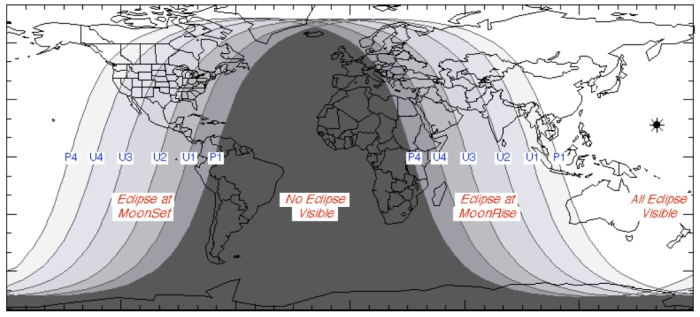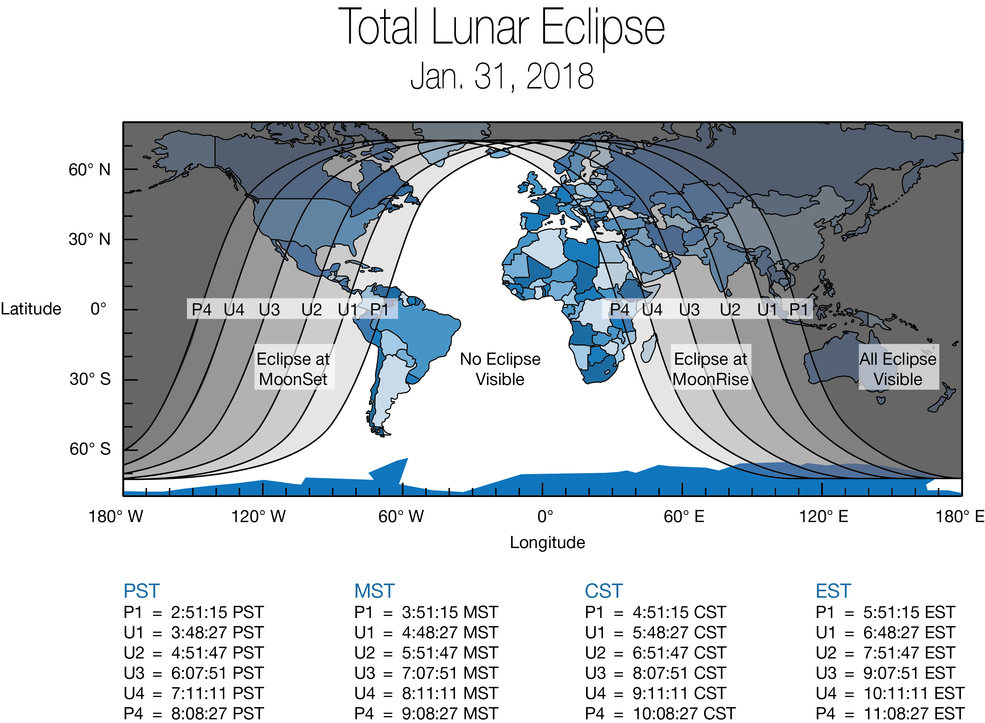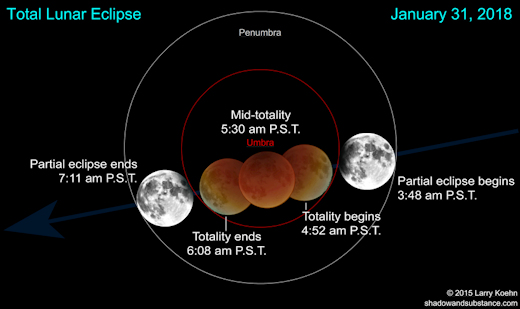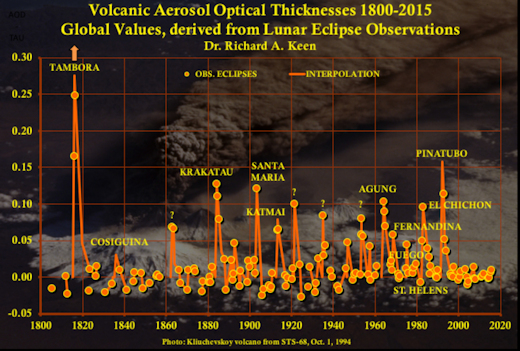Supermaan, blauwe maan en bloedmaan in 1 op 31 januari

Credit: Fred Espenak/NASA
Wie heeft de supermaan op nieuwjaarsdag gezien? Niet?....wel we krijgen een nieuwe kans en dan nog wel een kans met een heel speciaal tintje:
Op 31 januari rond middernacht, krijgen we te maken met een verschijnsel dat we voor het laatst 150 geleden hebben gezien:
De maan zal, Supermaan , blauwe maan én bloedmaan zijn!
De term supermaan zal bij eenieder wel bekend zijn nu, daar we afgelopen jaar meermalen hierop getrakteerd zijn. De maan staat dan het dichtst op de aarde, waardoor hij 7% groter lijkt. Al is deze nu weer net iets verder weg, dan toen de aarde op nieuwjaarsdag aan de hemel stond en het echt supermaan was.
Blauwe maan, spreken we van als het de tweede volle maan in de maand is. Dat gebeurt eens in de circa 2,5 jaar.
En als laatste maar niet de minste, hebben we ook nog eens te maken met een bloedmaan. Een bloedmaan krijg je te zien als de aarde precies tussen de zon en de maan staat. De schaduw van de aarde valt dan op de maan, waardoor deze een rode kleur krijgt.
Een mooi fenomeen dus voor de liefhebbers.De laatste keer dat we deze "3 op een rij" hadden was op 31 maart 1866
De bloedmaan zal het beste te zien zijn in oost Azië, Indonesië, Nieuw Zeeland en Australië. Australië heeft de beste kaarten, daar zal de bloedmaan gedurende 1 uur en 16 minuten zichtbaar zijn.

©NASA
Origineel artikel, zie bron:
Bron: http://www.sciencealert.com/
Maar kan alsnog niet wachten om deze speciale gebeurtenis vast te leggen. (Al moet t dan wel droog zijn en tot op heden, BIJNA ALTIJD PECH).
Altijd wel jammer dat t daadwerkelijke verschijnsel, minder spectaculair is, dan, ik elke keer denk dat het is. Als t te zien is uberhaupt.
Welke invloed hebben vulkaanuitbarstingen op de helderheid van de bloedmaan?
Wednesday, Jan. 31st, there's going to be a "Blue Moon"–the second full Moon in a calendar month. People who go outside to look may see a different hue: bright orange. This Blue Moon is going to be eclipsed, swallowed by copper-colored shadow of Earth for more than an hour. The eclipse will be visible from Asia, Australia, and most of North America

Credit: Larry Koehn.
The bright orange color of the eclipse may be chalked up to volcanic activity–or rather, lack thereof. Atmospheric scientist Richard Keen from the University of Colorado explains:
"During a lunar eclipse, most of the light illuminating the Moon passes through Earth's stratosphere where it is reddened by scattering," he says. "If the stratosphere is loaded with dust from volcanic eruptions, the eclipse will be dark. The cataclysmic explosion of Tambora in 1815, for instance, turned the Moon into a dark, starless hole in sky during two subsequent eclipses."
But Earth is experiencing a bit of a volcanic lull. We haven't had a major volcanic blast since 1991 when Mt Pinatubo awoke from a 500 year slumber and sprayed ten billion cubic meters of ash, rock and debris into Earth's atmosphere. Recent eruptions have been puny by comparison and have failed to make a dent on the stratosphere. To Keen, the interregnum means one thing: "This eclipse is going to be bright and beautiful."

From "Two Centuries of Volcanic Aerosols Derived from Lunar Eclipse Records" by R. A. Keen
Keen studies lunar eclipses because of what they can tell us about Earth's energy balance. A transparent stratosphere "lets the sunshine in" and actually helps warm the Earth below. "The lunar eclipse record indicates a clear stratosphere has contributed about 0.2 degrees to warming since the 1980s."
"Mt. Pinatubo finished a 110-year episode of frequent major eruptions that began with Krakatau in 1883," he says. "Since then, lunar eclipses have been relatively bright, and the Jan. 31st eclipse should be no exception."
In the USA, the best time to look is during the hours before sunrise. Western states are favored: The Moon makes first contact with the core of Earth's shadow at 3:48 am Pacific Time, kicking off the partial eclipse. Totality begins at 4:52 am PST as Earth's shadow engulfs the lunar disk for more than an hour. "Maximum orange" is expected around 5:30 am PST. Easternmost parts of the USA will miss totality altogether.
"I welcome any and all reports on the brightness of this eclipse for use in my volcano-climate studies," says Keen. While actual brightness measurements (in magnitudes) made near mid-totality are most useful, I can also make use of Danjon-scale ratings.
Het hele onderzoek is hier te lezen:
https://www.esrl.noaa.gov/gmd/publications/annual_meetings/2017/slides/7-Keen.pdf
Bron: http://www.spaceweather.com/
Het is "Maan-dag" !
Vandaag is het zover, supermaan, blauwe maan en bloedmaan, al zullen wij van de bloedmaan hier niks zien en mogen we in onze handjes klappen als we van de blauwe maan wel wat zien.Daarom gisteren maar even van de gelegenheid gebruik gemaakt om de telescoop op te stellen .

Hieronder nogmaals het schema waar de bloedmaan (indien het weer meewerkt) te zien zal zijn:

Global map showing areas of the world that will experience (weather permitting) the January 31, 2018 'super blue blood moon.' The eclipse will be visible before sunrise on January 31 for those in North America, Alaska and Hawaii. For those in the Middle East, Asia, eastern Russia, Australia and New Zealand, the super blue blood moon can be seen during moonrise the evening of the 31st. Credit: NASA
Livestreams voor de bloedmaan zijn o.a.:
https://www.nasa.gov/nasalive
https://live.slooh.com/
https://www.nasa.gov/multimedia/nasatv/index.html#public
https://livestream.com/GriffithObservatoryTV
https://www.virtualtelescope.eu/
Hieronder nogmaals het schema waar de bloedmaan (indien het weer meewerkt) te zien zal zijn:
Het zal lokaal erg verschillen of het weer meewerkt. De neerslag van vandaag trekt weg naar Duitsland, en achter de neerslag komen losse buitjes het land binnen vanaf zee. Tussen de buien zal het geregeld even opklaren, dus met wat goeie timing kan de maan wel te zien zijn.
| Gewijzigd: 31 januari 2018, 17:51 uur, door Thijs.

 31 januari wordt een speciale "Maan- dag"
31 januari wordt een speciale "Maan- dag"





